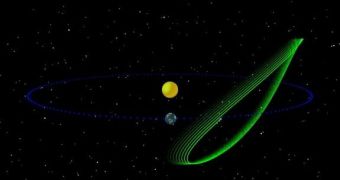Astronomers long ago proposed the existence of asteroids or other space rocks that trail or precede our planet in its orbit around the Sun. The first such object was recently discovered, confirming that theoretical predictions were correct.
Experts say that this class of objects is characterized by the fact that they occupy the same heliocentric orbit Earth does, but also by the fact that they maintain a relatively constant distance from our planet.
Asteroid 2010 TK7 – the first of its class ever discovered – keeps its distance at more than 50 million miles (80 million kilometers). It is preceding Earth in its orbit, and experts calculate that it has a diameter of about 300 meters (1,000 feet).
Scientists call asteroids such as this one the Earth's Trojans. In theory, they are a lot easier to get to than it would be to land on the Moon. The fact that they actually exist is an incredible certification of very advanced astronomical calculations.
The reason why these objects are so important is also practical in nature. The surface of such asteroids may be laden with chemical elements that cannot be found on Earth, or which are very rare here.
Past investigations have revealed asteroids at the Trojan points for Jupiter, Neptune and Mars, in relation to the Sun. Each planet or star in the Universe has two such points, which are also known as Lagrangian points (L4 and L5).
Calculating the location of such a point is easy. Simply think of the Earth and the Sun, for example, as a straight line, and then draw an equilateral triangle based on that line. There are two possibilities in this scenario, and the results are the two Trojan points.
Experts say that asteroids such as 2010 TK7 do not orbit right at these special points. Rather, they take elongated, chaotic orbits around them. This behavior is caused by gravitational interferences from other bodies in the vicinity, Space reports.
Earth's first Trojan asteroid was discovered using the NASA Wide-field Infrared Survey Explorer (WISE), which was launched two years ago. Since then, it has already completed 1 and a half maps of the entire Universe.
“It's as though the Earth is playing follow the leader. Earth is always chasing this asteroid around,” says NEOWISE principal investigator Amy Mainzer. She is based at the NASA Jet Propulsion Laboratory (JPL), in Pasadena, California, but was not a part of the work.
Details of the investigation were published in the July 28 issue of the top scientific journal Nature.

 14 DAY TRIAL //
14 DAY TRIAL //